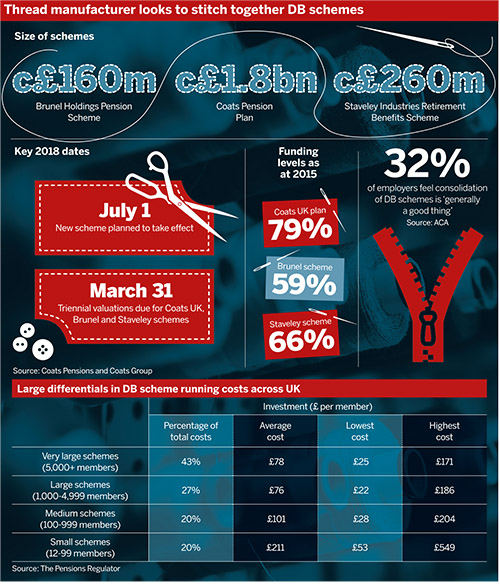Industrial thread manufacturer Coats has proposed a merger of its three UK defined benefit pension schemes to cut costs and increase efficiency.
In its white paper published in March, the Department for Work and Pensions highlighted the importance of raising awareness of existing forms of consolidation.
It noted that amalgamating schemes can help reduce running costs per member while leading to more efficient and effective investment strategies, as well as improved governance.
Trustees will be looking very carefully at balances of powers
Alastair Meeks, Pinsent Masons
The government also encouraged the creation of commercial consolidators, outlining plans to consult on a legislative framework and authorisation regime to enable consolidation in which an employer no longer sponsors their DB scheme.
It might still be some time before commercial consolidation becomes commonplace, but many sponsors supporting more than one DB fund already have the option to achieve economies of scale.
Numerous companies might have multiple schemes as a result of corporate activity, and some choose to bring together legacy schemes to improve governance and save money.
Earlier this year, Sainsburys revealed plans to combine its two DB schemes to save on pension costs. Similarly, in the year to April 2016, Stagecoach combined its East London and Selkent Pension Scheme into its main pension fund.
Coats has proposed to merge its three DB funds, comprising the roughly £160m Brunel Holdings Pensions Scheme, £260m Staveley Industries Retirement Benefits Scheme and the circa £1.8bn Coats Pension Plan, into a single scheme.
Members were told in March that the company has asked the trustees of the plan “to agree to the transfer of all benefits under the existing plan into a new pension scheme called the Coats UK Pension Scheme”.
The company has proposed that members’ pension benefits will be provided by this new scheme from July 1 2018.
A spokesperson said: “We started discussion with the trustees in [the] second half of 2017… We’re working through the details at the moment so nothing’s been formally agreed, but we’re hopeful that we can complete during the summer.”
Merger would cut costs and boost efficiency
Currently, the three schemes are all supported by the same sponsoring employer but operated separately, with three trustee boards and three sets of advisers.
The spokesperson said: “Bringing them together will bring through savings in terms of professional fees and costs and additional efficiencies over time through bringing all the investments under one scheme.”
Some companies opt for a sectionalised merger. This means that each section is treated more like a separate scheme for actuarial and administrative purposes.
If the Coats scheme consolidation goes through as planned it will be “one single scheme, all assets and liabilities are merged together”, the spokesperson said.
As a result, “there’ll be a new trustee board with representatives from the current three separate boards”.
Member benefits will not be changed, according to the spokesperson.
Funding obstacles can hinder consolidation
Nicola Rondel, counsel at law firm Hogan Lovells, said scheme mergers can lead to “greater economies of scale in terms of investment of scheme assets”, in addition to one trustee board, one set of advisers and one set of communications.
Some obstacles to agreeing to a proposed merger involve funding. Trustees of a well funded scheme are “not going to want to merge or have their members move to a scheme that is less well funded because it means that the funding level is diluted” and it becomes less secure.

Likewise, if the well funded scheme is the receiving scheme, the trustees are not going to want to take on benefits that are not funded to the same level, said Rondel.
She noted that often mergers require an employer to put in payments to the less well funded schemes so that all the schemes have an equivalent funding level.
Coats has said that benefits would be transferred into a new scheme.
When schemes are merged, there are sometimes receiving and transferring schemes, “and that can cause issues with the trustees, because the trustees of the transferring scheme might feel that their nose is being put out of joint because there is already a trustee board”.
If a company sets up a brand new scheme, “possibly one of the advantages is that none of the trustees of the… schemes feel that they are further down the pecking order” and it might be a less sensitive and less political way of going through the process.
Trustee board’s cultures can clash
Vassos Vassou, senior trustee representative at Dalriada Trustees, said if he were a trustee of any scheme involved in a full merger, the initial concern for him would be ensuring that the security of his members’ benefits is not compromised in terms of funding.
“The other aspect I’d be worried about would be paying my members, so the administration side of things can be a little bit messy,” he said.
When there are separate sets of administrators and consultants, and then schemes are merged, reducing the number of advisers and administrators will cut costs, “which is good for everybody”.
However, “one administrator, for example, will be taking on two new schemes that they may not know anything about”, Vassou said.
There are also concerns about representation. Creating one single trustee board as a result of scheme consolidation is understandable, said Vassou, but “I’m going to want to make sure that that trustee board takes into account the issues and foibles of my own little scheme going forward”.
He added: “I would want some sort of representation on that trustee board for my scheme.”
This would however result in a mixture of trustees from different backgrounds, brought together into “one big melting pot”, who could have different ways of doing things.
While wider thinking and experience can be a benefit, “it can also slow the whole process down if people argue about what’s best and what’s worst”, Vassou added.
For a company, amalgamating its DB schemes can lead to cost savings and efficiency. For example, a full merger means that there only needs to be one triennial valuation, rather than multiple valuations.
There is also an element of consistency because “it removes the risk of schemes going off in different directions and doing different things”, Vassou said.
A question of perspective
Alastair Meeks, partner at law firm Pinsent Masons, said that three schemes being put together might look objectively better than each scheme being separate.
However, “questions about relative funding levels… [and] strength of current employer covenant both before and after are going to be questions that will weigh on trustees’ minds”, he said.
He echoed Vassou’s comments on concerns around culture clashes. “Different schemes will come from different bits of the business. Those different bits of the business may well reflect different corporate cultures,” Meeks said.
DB mergers take time
DB mergers require a lot of input from the schemes’ actuaries and lawyers, “making sure that all aspects are covered from different directions”, Meeks said.
Coats has advised members that the pensions team is likely to be very busy preparing to implement the system and data changes associated with this transfer, so there may be a delay to their normal timescales.
Amalgamating different areas of DB schemes, such as administration, can be a complicated and time-consuming process.
There are also costs involved. However, Meeks said that, as part of the due diligence process, “it’s not really an additional cost, very often it’s just really people focusing in on something which everyone had happily not focused in on but was going to have to be addressed at some point”.
Meeks said when it comes to DB mergers, “we’re seeing quite a bit of activity on that front”.














